engine FIAT LINEA 2008 1.G Manual PDF
[x] Cancel search | Manufacturer: FIAT, Model Year: 2008, Model line: LINEA, Model: FIAT LINEA 2008 1.GPages: 234, PDF Size: 3.41 MB
Page 197 of 234
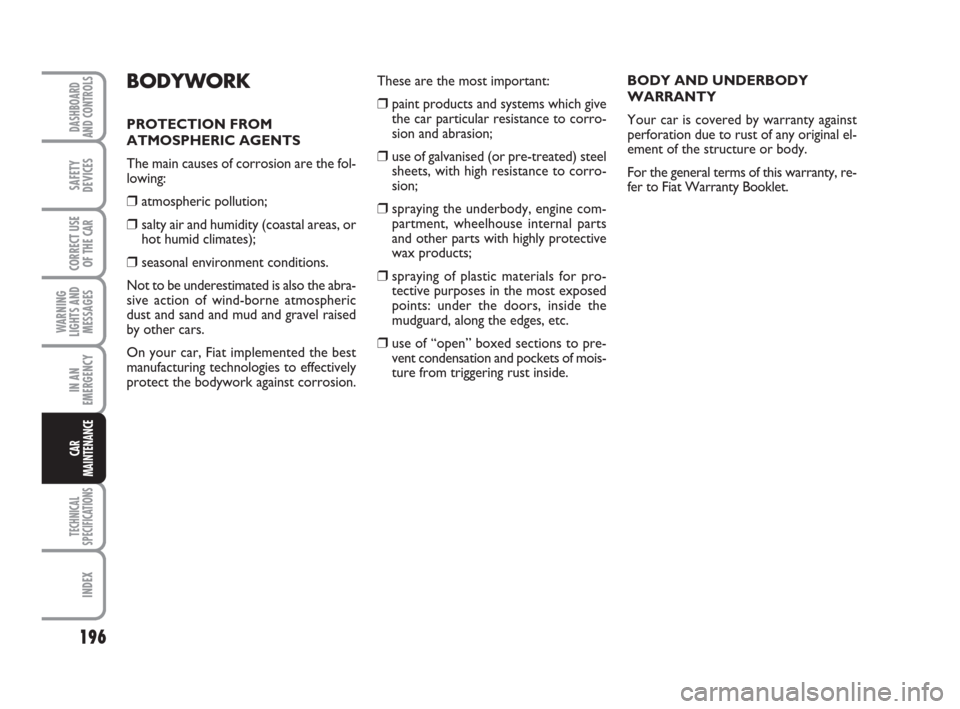
196
WARNING
LIGHTS AND
MESSAGES
TECHNICAL
SPECIFICATIONS
INDEX
DASHBOARD
AND CONTROLS
SAFETY
DEVICES
CORRECT USE
OF THE CAR
IN AN
EMERGENCY
CAR
MAINTENANCE
BODY AND UNDERBODY
WARRANTY
Your car is covered by warranty against
perforation due to rust of any original el-
ement of the structure or body.
For the general terms of this warranty, re-
fer to Fiat Warranty Booklet.BODYWORK
PROTECTION FROM
ATMOSPHERIC AGENTS
The main causes of corrosion are the fol-
lowing:
❒atmospheric pollution;
❒salty air and humidity (coastal areas, or
hot humid climates);
❒seasonal environment conditions.
Not to be underestimated is also the abra-
sive action of wind-borne atmospheric
dust and sand and mud and gravel raised
by other cars.
On your car, Fiat implemented the best
manufacturing technologies to effectively
protect the bodywork against corrosion.These are the most important:
❒paint products and systems which give
the car particular resistance to corro-
sion and abrasion;
❒use of galvanised (or pre-treated) steel
sheets, with high resistance to corro-
sion;
❒spraying the underbody, engine com-
partment, wheelhouse internal parts
and other parts with highly protective
wax products;
❒spraying of plastic materials for pro-
tective purposes in the most exposed
points: under the doors, inside the
mudguard, along the edges, etc.
❒use of “open” boxed sections to pre-
vent condensation and pockets of mois-
ture from triggering rust inside.
177-200 LINEA 1ed GB 3-09-2008 17:31 Pagina 196
Page 198 of 234
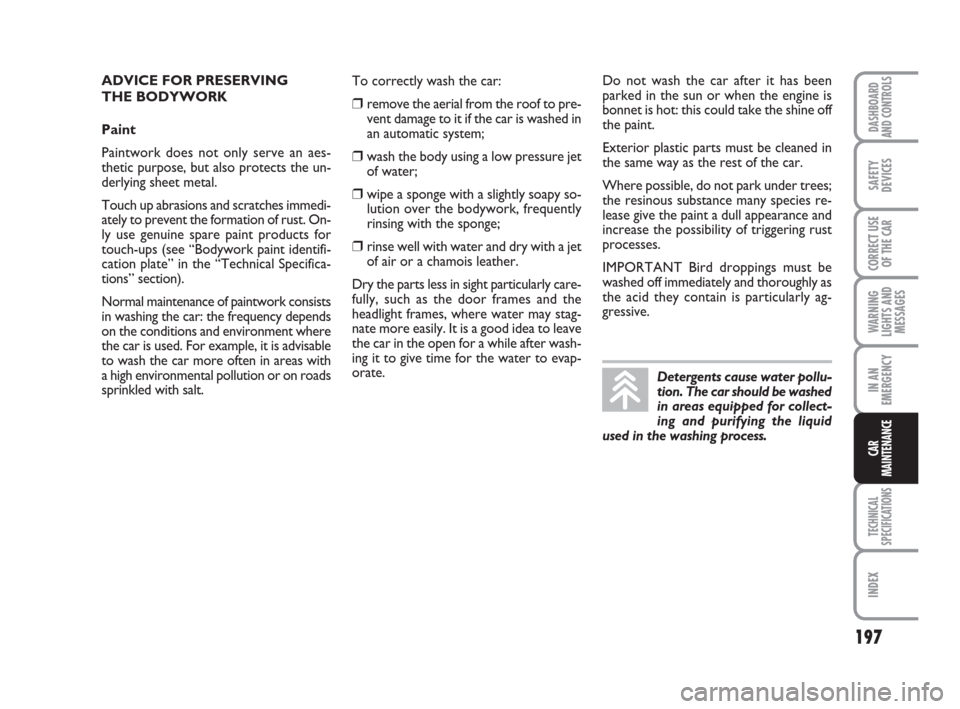
197
WARNING
LIGHTS AND
MESSAGES
TECHNICAL
SPECIFICATIONS
INDEX
DASHBOARD
AND CONTROLS
SAFETY
DEVICES
CORRECT USE
OF THE CAR
IN AN
EMERGENCY
CAR
MAINTENANCE
ADVICE FOR PRESERVING
THE BODYWORK
Paint
Paintwork does not only serve an aes-
thetic purpose, but also protects the un-
derlying sheet metal.
Touch up abrasions and scratches immedi-
ately to prevent the formation of rust. On-
ly use genuine spare paint products for
touch-ups (see “Bodywork paint identifi-
cation plate” in the “Technical Specifica-
tions” section).
Normal maintenance of paintwork consists
in washing the car: the frequency depends
on the conditions and environment where
the car is used. For example, it is advisable
to wash the car more often in areas with
a high environmental pollution or on roads
sprinkled with salt.To correctly wash the car:
❒remove the aerial from the roof to pre-
vent damage to it if the car is washed in
an automatic system;
❒wash the body using a low pressure jet
of water;
❒wipe a sponge with a slightly soapy so-
lution over the bodywork, frequently
rinsing with the sponge;
❒rinse well with water and dry with a jet
of air or a chamois leather.
Dry the parts less in sight particularly care-
fully, such as the door frames and the
headlight frames, where water may stag-
nate more easily. It is a good idea to leave
the car in the open for a while after wash-
ing it to give time for the water to evap-
orate.Do not wash the car after it has been
parked in the sun or when the engine is
bonnet is hot: this could take the shine off
the paint.
Exterior plastic parts must be cleaned in
the same way as the rest of the car.
Where possible, do not park under trees;
the resinous substance many species re-
lease give the paint a dull appearance and
increase the possibility of triggering rust
processes.
IMPORTANT Bird droppings must be
washed off immediately and thoroughly as
the acid they contain is particularly ag-
gressive.
Detergents cause water pollu-
tion. The car should be washed
in areas equipped for collect-
ing and purifying the liquid
used in the washing process.
177-200 LINEA 1ed GB 3-09-2008 17:31 Pagina 197
Page 199 of 234

198
WARNING
LIGHTS AND
MESSAGES
TECHNICAL
SPECIFICATIONS
INDEX
DASHBOARD
AND CONTROLS
SAFETY
DEVICES
CORRECT USE
OF THE CAR
IN AN
EMERGENCY
CAR
MAINTENANCE
Windows
Use specific window cleaner products.
Use also clean cloths to avoid scratching
the glass or damaging the transparency.
IMPORTANT The inside of the rear win-
dow should be wiped gently with a cloth
in the direction of the filaments to avoid
damaging the heating device.
Engine compartment
Wash the engine compartment carefully
after the end of the winter. Be careful not
to direct the jet of water onto electronic
control units. Adequately protect the up-
per air vents to prevent damage to the
windscreen wiper motor. Have this op-
eration performed at a specialised work-
shop.
IMPORTANT Perform this operation on
a cold engine and with the key at STOP.
After the washing operation, make sure
that the various protections (e.g. rubber
caps and guards) have not removed or
damaged.
Never use flammable prod-
ucts, such as petrol ether or
rectified petrol to clean inside the car.
The electrostatic charges which are
generated by rubbing during the
cleaning operation may cause a fire.
WARNING
INTERIORS
Periodically check that water is not
trapped under the mats (due to water
dripping off shoes, umbrellas, etc.) which
could cause oxidisation of the sheet
metal. Front headlights
IMPORTANT Never use aromatic sub-
stances (e.g.: petrol) or ketenes (e.g.: ace-
tone) for cleaning front headlight plastic
lens.
177-200 LINEA 1ed GB 3-09-2008 17:31 Pagina 198
Page 202 of 234

201
WARNING
LIGHTS AND
MESSAGES
INDEX
DASHBOARD
AND CONTROLS
SAFETY
DEVICES
CORRECT USE
OF THE
CAR
IN AN
EMERGENCY
CAR
MAINTENANCE
TECHNICAL
SPECIFICATIONS
IDENTIFICATION DATA ................................................. 202
ENGINE CODES - BODYWORK VERSIONS............... 204
ENGINE .................................................................................. 205
FUEL FEED/IGNITION ....................................................... 206
TRANSMISSION .................................................................. 207
BRAKES................................................................................... 207
SUSPENSIONS....................................................................... 208
STEERING............................................................................... 208
WHEELS.................................................................................. 209
DIMENSIONS......................................................................... 213
PERFORMANCE................................................................... 214
WEIGHTS............................................................................... 215
CAPACITIES........................................................................... 216
FLUIDS AND LUBRICANTS.............................................. 217
FUEL CONSUMPTION....................................................... 219
CO
2EMISSIONS .................................................................. 221
TT T
E E
C C
H H
N N
I I
C C
A A
L L
S S
P P
E E
C C
I I
F F
I I
C C
A A
T T
I I
O O
N N
S S
201-221 LINEA 1ed GB 5-09-2008 9:24 Pagina 201
Page 203 of 234

202
WARNING
LIGHTS AND
MESSAGES
INDEX
DASHBOARD
AND CONTROLS
SAFETY
DEVICES
CORRECT USE
OF THE
CAR
IN AN
EMERGENCY
CAR
MAINTENANCE
TECHNICAL
SPECIFICATIONS
MODEL PLATE fig. 1
This is applied to the right-hand side of the
spare wheel shelf and shows the following
data:
BHomologation number.
CVehicle type code.
DChassis number.
EMaximum vehicle weight fully loaded.
FMaximum vehicle weight fully loaded
with trailer.
GMaximum vehicle weight on front axle.HMaximum vehicle weight on rear axle.
IEngine type.
LBody version code.
MSpare part code.
NSmoke opacity index (for diesel en-
gines).
IDENTIFICATION DATA
Take note of the identification codes. The
following identification codes are printed
and shown on the plates:
❒Model plate.
❒Chassis marking.
❒Bodywork paint identification plate.
❒Engine marking.fig. 1F0R0247m
201-221 LINEA 1ed GB 5-09-2008 9:24 Pagina 202
Page 204 of 234
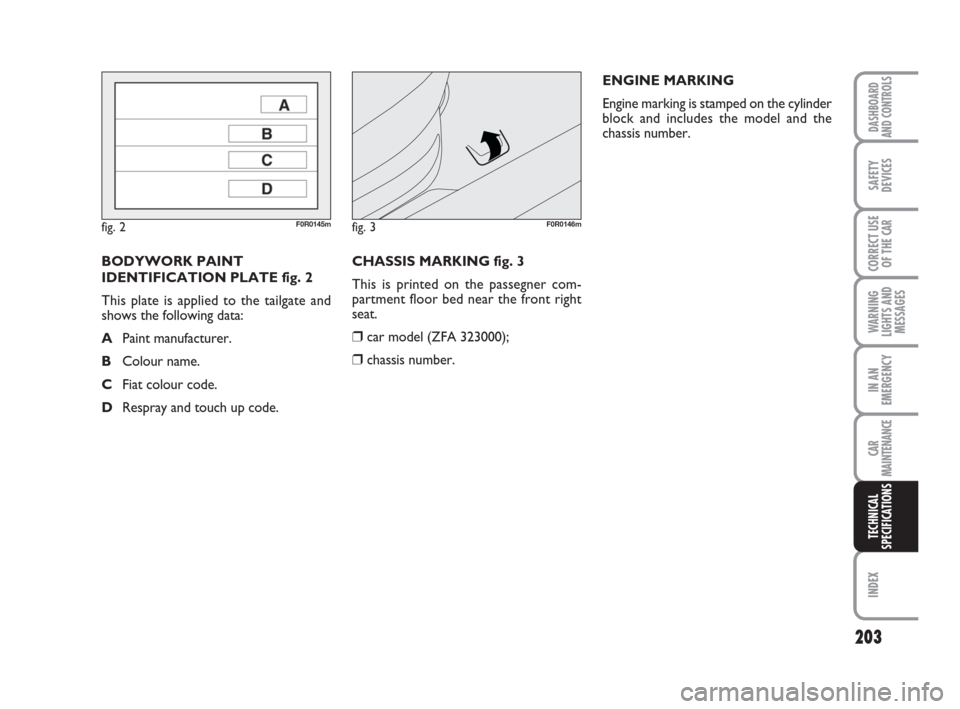
203
WARNING
LIGHTS AND
MESSAGES
INDEX
DASHBOARD
AND CONTROLS
SAFETY
DEVICES
CORRECT USE
OF THE
CAR
IN AN
EMERGENCY
CAR
MAINTENANCE
TECHNICAL
SPECIFICATIONS
CHASSIS MARKING fig. 3
This is printed on the passegner com-
partment floor bed near the front right
seat.
❒car model (ZFA 323000);
❒chassis number.ENGINE MARKING
Engine marking is stamped on the cylinder
block and includes the model and the
chassis number.
BODYWORK PAINT
IDENTIFICATION PLATE fig. 2
This plate is applied to the tailgate and
shows the following data:
APaint manufacturer.
BColour name.
CFiat colour code.
DRespray and touch up code.
fig. 2F0R0145mfig. 3F0R0146m
201-221 LINEA 1ed GB 5-09-2008 9:24 Pagina 203
Page 205 of 234
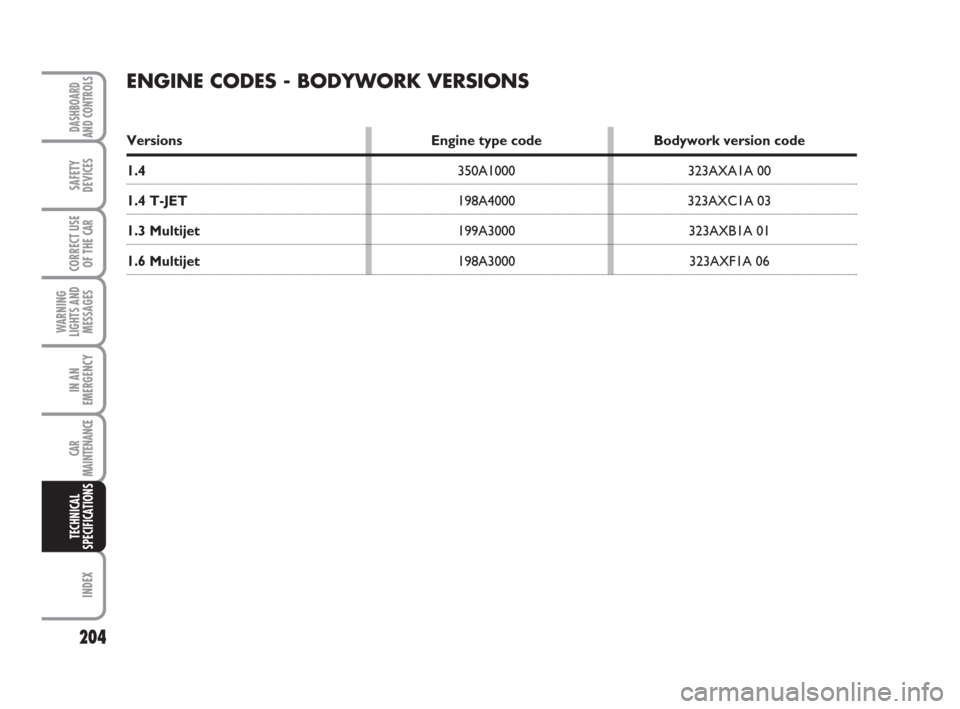
204
WARNING
LIGHTS AND
MESSAGES
INDEX
DASHBOARD
AND CONTROLS
SAFETY
DEVICES
CORRECT USE
OF THE
CAR
IN AN
EMERGENCY
CAR
MAINTENANCE
TECHNICAL
SPECIFICATIONS
ENGINE CODES - BODYWORK VERSIONS
Versions Engine type code Bodywork version code
1.4 350A1000 323AXA1A 00
1.4 T-JET198A4000 323AXC1A 03
1.3 Multijet 199A3000 323AXB1A 01
1.6 Multijet 198A3000 323AXF1A 06
201-221 LINEA 1ed GB 5-09-2008 9:24 Pagina 204
Page 206 of 234

205
WARNING
LIGHTS AND
MESSAGES
INDEX
DASHBOARD
AND CONTROLS
SAFETY
DEVICES
CORRECT USE
OF THE
CAR
IN AN
EMERGENCY
CAR
MAINTENANCE
TECHNICAL
SPECIFICATIONS
ENGINE
GENERAL
Engine code
Cycle
Number and layout of cylinders
Piston bore and stroke mm
Total displacement cm3
Compression ratio
Maximum power (EEC) kW
HP
corresponding ratio rpm
Maximum torque (EEC) Nm
kgm
corresponding ratio rpm
Spark plugs
Fuel
1.4
350A1000
Otto
4 in line
72 x 84
1368
11.1 ± 0.2
57
77
6000
115
11.7
3000
NGK
ZKR7A-10
Unleaded petrol 95
RON
(EN228 Specifications)
1.4 T-JET
198A4000
Otto
4
in line
72,0 x 84,0
1368
9.8
88
120
5000
206
21
1750
NGK
IKR9F8
Unleaded petrol 95
RON
(EN228 Specifications)
1.3 Multijet
199A3000
Diesel
4 in line
69.6 x 82
1248
17.6 ± 0.4
66
90
4000
200
20.3
1750
–
Diesel fuel for motor
vehicles
(EN590 specifications)
1.6 Multijet
198A3000
Diesel
4 in line
79.5 x 80.5
1598
16.5 ± 0.4
77
105
4000
290
29.6
1500
–
Diesel fuel for motor
vehicles
(EN590 specifications)
201-221 LINEA 1ed GB 5-09-2008 9:24 Pagina 205
Page 217 of 234
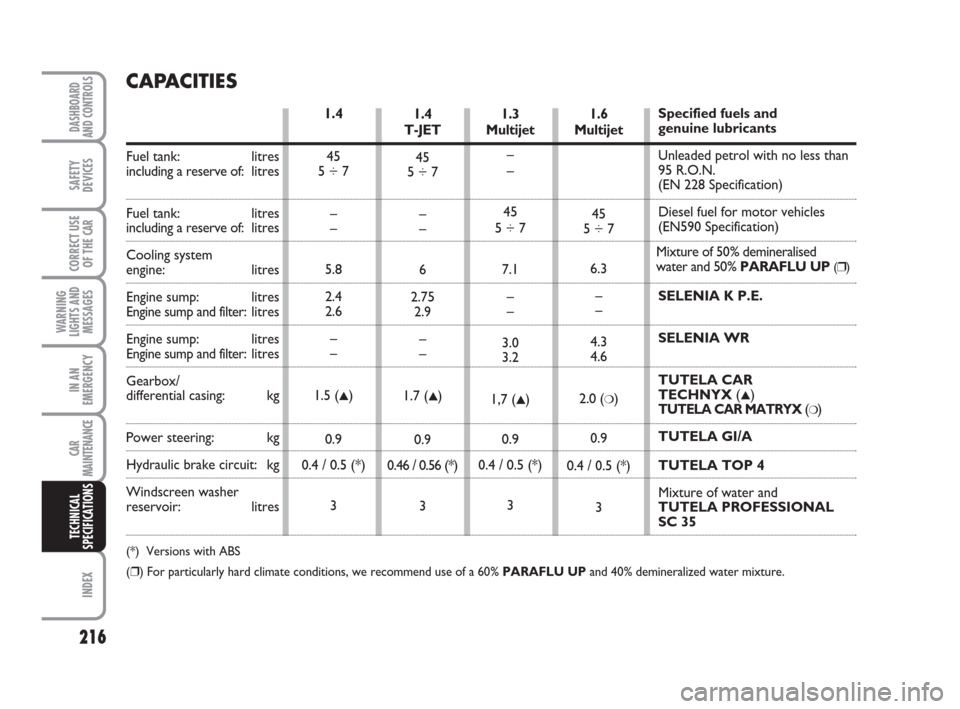
216
WARNING
LIGHTS AND
MESSAGES
INDEX
DASHBOARD
AND CONTROLS
SAFETY
DEVICES
CORRECT USE
OF THE
CAR
IN AN
EMERGENCY
CAR
MAINTENANCE
TECHNICAL
SPECIFICATIONS
CAPACITIES
Fuel tank: litres
including a reserve of:litres
Fuel tank: litresincluding a reserve of:litres
Cooling system
engine: litres
Engine sump: litres
Engine sump and filter:litres
Engine sump: litres
Engine sump and filter:litres
Gearbox/
differential casing: kg
Power steering: kg
Hydraulic brake circuit: kg
Windscreen washer
reservoir: litres
(*) Versions with ABS
(❒) For particularly hard climate conditions, we recommend use of a 60% PARAFLU UPand 40% demineralized water mixture.
1.6
Multijet
45
5 ÷ 7
6.3
–
–
4.3
4.6
2.0 (
❍)
0.9
0.4 / 0.5 (*)
3 1.4
T-JET
45
5 ÷ 7
–
–
6
2.75
2.9
–
–
1.7 (▲)
0.9
0.46 / 0.56 (*)
31.3
Multijet
–
–
45
5 ÷ 7
7.1
–
–
3.0
3.2
1,7 (▲)
0.9
0.4 / 0.5 (*)
3 1.4
45
5 ÷ 7
–
–
5.8
2.4
2.6
–
–
1.5 (▲)
0.9
0.4 / 0.5 (*)
3Specified fuels and
genuine lubricants
Unleaded petrol with no less than
95 R.O.N.
(EN 228 Specification)
Diesel fuel for motor vehicles
(EN590 Specification)
Mixture of 50% demineralised
water and 50% PARAFLU UP
(❒)
SELENIA K P.E.
SELENIA WR
TUTELA CAR
TECHNYX (
▲)TUTELA CAR MATRYX (❍)
TUTELA GI/A
TUTELA TOP 4
Mixture of water and
TUTELA PROFESSIONAL
SC 35
201-221 LINEA 1ed GB 5-09-2008 9:24 Pagina 216
Page 218 of 234

217
WARNING
LIGHTS AND
MESSAGES
INDEX
DASHBOARD
AND CONTROLS
SAFETY
DEVICES
CORRECT USE
OF THE
CAR
IN AN
EMERGENCY
CAR
MAINTENANCE
TECHNICAL
SPECIFICATIONS
According to
Service Schedule
According to
Service Schedule
FLUIDS AND LUBRICANTS
RECOMMENDED PRODUCTS AND SPECIFICATIONS
Use Fluid and lubricant specifications Genuine fluids and Changing
for correct car operation lubricants frequency
Lubricants for
petrol engines
Lubricants for
diesel engines
For diesel engines, in the event of emergencies when genuine products are not available, lubricants providing at least ACEA B4
performance are allowed; in that case, engine best performance is not guaranteed; we recommend to have it replaced as soon as
possible with the recommended lubricants by the Fiat Dealership.
The use of products with specifications below ACEA A3/B3 standards for petrol engines and ACEA B4 standards for diesel engines
could cause damage to the engine not covered under the warranty.SAE 5W-40 ACEA A3/B3 grade totally
synthetic lubricant.
Qualification FIAT 9.55535-M2
Synthetic base lubricants SAE 5W-40 grade.
Qualification FIAT 9.55535-N2 SELENIA K
Contractual Technical
Reference N° F214.I05
SELENIA WR
Contractual Technical
Reference N° F515.D06
201-221 LINEA 1ed GB 5-09-2008 9:24 Pagina 217